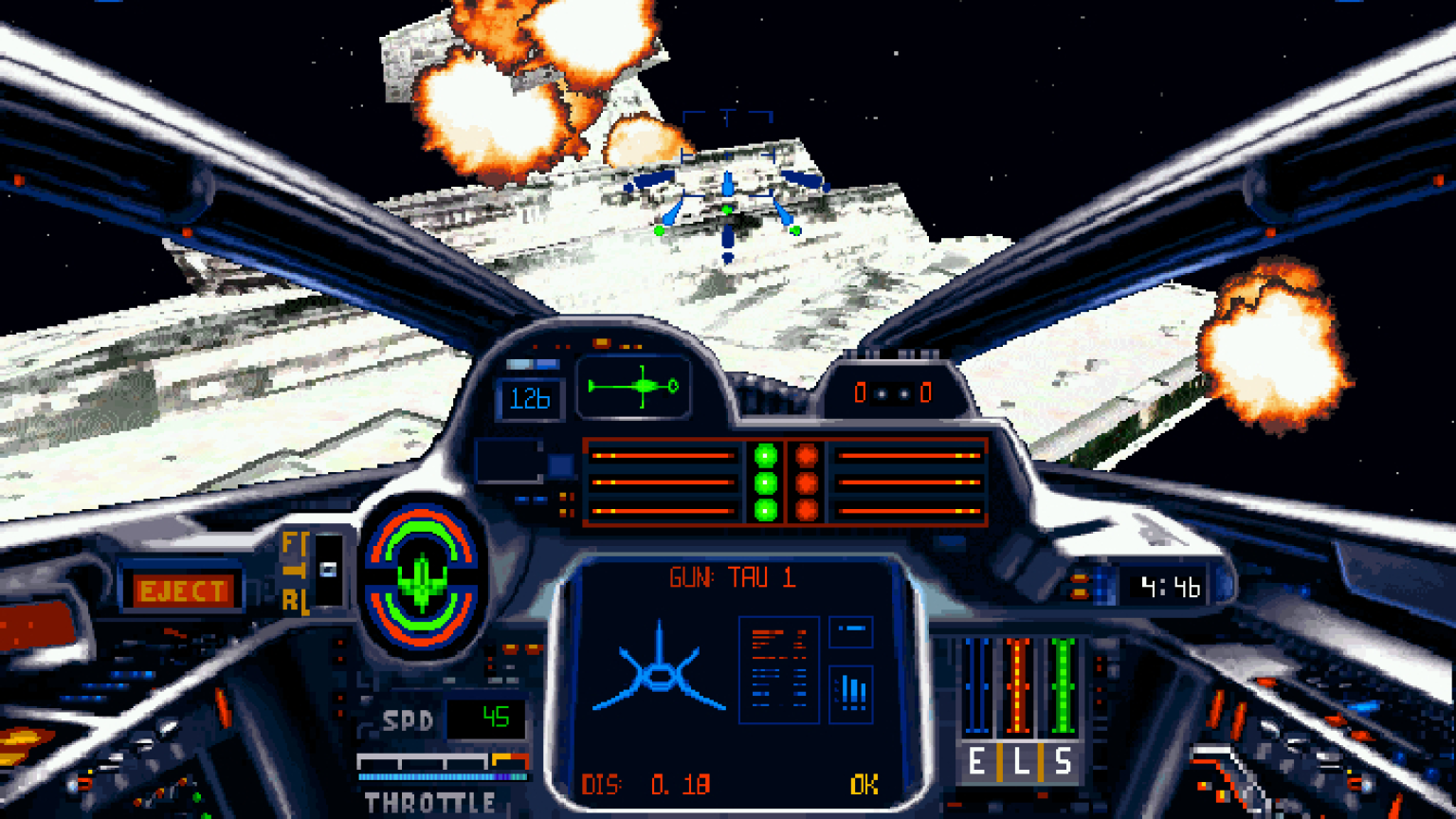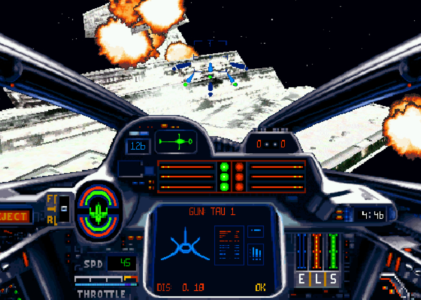In a galaxy far, far away, the iconic Star Wars franchise took flight like never before with the release of “Star Wars: X-Wing” in 1993. This groundbreaking space combat simulator not only thrilled fans of the beloved universe but also set the standard for immersive gameplay and cultural impact. Join us as we delve deep into the world of X-Wing, exploring its genre, platforms, gameplay, key features, strategies, reviews, cultural influence, sequels, and similar gaming experiences.
The Birth of a Galactic Phenomenon
In the early ’90s, LucasArts, the gaming division of Lucasfilm Ltd., was on a mission to bring the Star Wars universe to life on computer screens. The result was “Star Wars: X-Wing,” a game that would become a legend in its own right.

Genre and Platforms
Star Wars: X-Wing can be best described as a space combat simulation game. It falls within the subgenre of space flight simulations, providing players with an opportunity to step into the cockpit of iconic Star Wars starfighters and engage in thrilling dogfights. The game was initially released for MS-DOS, a popular operating system of the time, and later made its way to platforms like Macintosh and Amiga.
The MS-DOS version featured crisp VGA graphics, and players could experience the game’s rich audio through their Sound Blaster or AdLib sound cards. The game’s accessibility across multiple platforms ensured that Star Wars fans could engage in epic space battles regardless of their preferred system.

Gameplay: Taking to the Stars
“X-Wing” placed players in the role of a Rebel Alliance pilot, tasked with a series of missions to thwart the evil Galactic Empire. The game’s immersive storyline, set during the original Star Wars trilogy, allowed players to become a part of the epic space opera.
Key Gameplay Features
1. Authentic Starfighter Experience: “X-Wing” offered a remarkable level of authenticity, recreating the iconic starfighters from the movies with meticulous attention to detail. Players could pilot X-Wings, Y-Wings, A-Wings, and even the legendary Millennium Falcon, each with its unique handling characteristics.
2. Diverse Missions: The game featured a wide variety of missions, from escorting Rebel convoys and assaulting Imperial bases to engaging in epic fleet battles. Each mission challenged players to utilize their starfighter’s capabilities strategically.
3. Realistic Combat: “X-Wing” was renowned for its realistic space combat mechanics. It emphasized the importance of energy management, shield distribution, and the careful use of onboard systems, adding depth to the gameplay.
4. Advanced AI: The game introduced players to intelligent enemy AI, making dogfights engaging and unpredictable. TIE Fighters and Star Destroyers would react to the player’s actions, creating dynamic battles.
5. Mission Briefings and Debriefings: Before and after each mission, players received detailed briefings and debriefings that added to the immersion. These briefings provided mission objectives, while debriefings evaluated the player’s performance.

Strategies for Victory
Achieving success in “X-Wing” demanded not only piloting skills but also strategic thinking:
– Energy Management: Balancing laser energy, shields, and engine power was crucial. Distributing energy effectively allowed players to stay in the fight longer.
– Target Priority: Identifying high-value targets like enemy capital ships and missile platforms was essential. Focusing on these objectives often determined mission success.
– Use of Countermeasures: Deploying countermeasures like chaff and flares at the right moment could save the player’s starfighter from incoming missiles.
– Wingman Management: Players could issue orders to their wingmen, making teamwork an important aspect of the game.
Reviews and Cultural Impact
“Star Wars: X-Wing” was not just another Star Wars game; it was a revolutionary experience that garnered widespread acclaim.
Critical Acclaim
Upon its release, the game received stellar reviews from critics. It was praised for its attention to detail, immersive gameplay, and the way it allowed players to step into the Star Wars universe. Many hailed it as one of the greatest space combat simulators of its time.
Cultural Influence
The impact of “X-Wing” extended beyond the gaming world. It helped keep the Star Wars franchise alive during a period when new movies were scarce. The game’s success paved the way for a resurgence of interest in the franchise, eventually leading to the creation of the prequel trilogy.
“X-Wing” also played a significant role in expanding the Star Wars Extended Universe (now known as Star Wars Legends). It introduced fans to new characters, starfighters, and lore, enriching the already vast Star Wars universe.
Sequels and Continued Legacy
The success of “X-Wing” led to the development of several sequels and expansions, each building upon the foundation laid by the original game.
X-Wing: TIE Fighter (1994)
In 1994, LucasArts released “X-Wing: TIE Fighter,” a companion game that allowed players to experience the Galactic Civil War from the perspective of the Empire. This sequel expanded on the gameplay mechanics of “X-Wing” and provided a deeper look into the Empire’s side of the conflict.
X-Wing Alliance (1999)
“X-Wing Alliance” continued the saga in 1999, focusing on the family of Azzameen pilots. It featured improved graphics and gameplay elements, further refining the space combat simulator experience.
Legacy and Influence
The X-Wing series left an indelible mark on gaming, inspiring future space combat titles like the “Wing Commander” series and “Freespace.” It also influenced the development of modern space sims such as “Elite Dangerous” and “Star Citizen.”
Examples of Similar Games
If you’re a fan of “Star Wars: X-Wing” and are looking for similar gaming experiences, you’re in luck. Several games capture the essence of space combat and immersive storytelling:
1. “Wing Commander” Series
The “Wing Commander” series, developed by Origin Systems, is a classic in the space combat genre. It offers engaging stories, memorable characters, and intense dogfights in the depths of space.
2. “Freespace 2” (1999)
“Freespace 2” is often hailed as one of the best space combat simulators of all time. It features a gripping narrative, stunning graphics (for its time), and epic battles against a variety of foes.
3. “Elite Dangerous” (2014)
“Elite Dangerous” offers a vast open galaxy for players to explore, trade, and engage in intense space combat. It combines the excitement of space battles with the freedom of an open-world sandbox.
4. “Star Citizen” (Ongoing Development)
“Star Citizen” is an ambitious ongoing project that aims to create the ultimate space simulation experience. It features a vast persistent universe, detailed ship customization, and a strong focus on realism.
Star Wars: X-Wing
“Star Wars: X-Wing” isn’t just a game; it’s a journey to a galaxy far, far away. Its genre-defining gameplay, attention to detail, and cultural impact continue to resonate with fans today. From its roots on MS-DOS to its influence on modern space sims, “X-Wing” will forever hold a special place in the hearts of Star Wars enthusiasts and gamers alike.
So, whether you’re an aspiring Rebel pilot or a seasoned gamer looking to relive the magic of “X-Wing,” strap in, engage your hyperdrive, and prepare for the adventure of a lifetime. The stars are waiting, and the Force is strong with this one.
May the Force be with you.
References:

